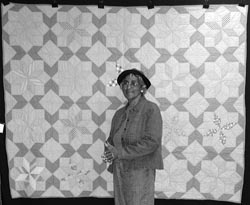Quilts as Women's Documents: The Louisiana Quilt Documentation Project
By Susan Roach and Laura Westbrook
"Quilting is a connection to generations of women before you, making something beautiful but useful. It's a connection to our past-and we still need covers."
- Susan Muller, New Orleans, January 26, 2003"Making this quilt brought back memories of the old quilting bees that my mother held at her home when I was a child. At the top of the house were rafters where the ropes connected to wooden quilting frames were hung. Neighbor women were invited. Each woman would quilt a block about two feet square. As each row of women finished their squares, the frames were taken up to the next unquilted part. This was a fun time; coffee and cake were served. The men who escorted their wives to the quilting were served homemade blackberry wine or muscadine wine with their cake. Quilting bees were a real social event in the community."
- Agnes Hicks, Winnsboro, March 18, 2002
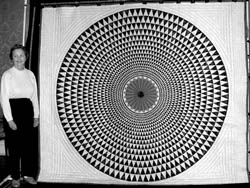
Chicken feed sacks, heirloom handkerchiefs, old neckties, homespun from family-owned sheep, children's holiday clothes, historic political ribbons, T-shirts marking athletic victories, suit samples, sewing scraps, tobacco sacks-a stunning variety of materials have inspired Louisiana quilters to create works of utility and art. "I love the 'necktie crazy quilt' my grandmother made in the 1960s. I use it just about every evening, and it always reminds me of her and of my uncle, who lived in New York and wore these fancy silk ties," says Robert Baxter of New Orleans, who also brought two very traditional turn-of-the-century quilts made by his great-grandmother to be documented by the Louisiana Quilt Documentation Project.
Examining quilts provides a window into women's lives throughout Louisiana's history-their family's clothing, favorite colors and aesthetic preferences, travels, experiences, memories, significant events, and even socioeconomic status. The quilts serve as documents we can read to learn about their makers and the people who used and kept the quilts, revealing periods of prosperity through crisp, new fabrics or lean times-the chicken feed, flour, and tobacco sacks common in the Depression or recycled double knit fabric from the 1970s. Quilts handed down through generations may serve as scrapbooks of family history. And like documents, quilts remain after their makers have gone.
To study the range of Louisiana quilts surviving from the days of earliest settlement to the present, Susan Roach started the Louisiana Quilt Documentation Project in 2001, as a research activity for the Louisiana Regional Folklife Program at Louisiana Tech University. In 2003, Laura Westbrook brought the project to the University of New Orleans branch of the program. Project goals include developing appreciation for quilting as an important expressive artistic form, assisting quilt owners in identifying and maintaining the history of family quilts, thereby preserving historic quilts, identifying quilts for exhibitions, and compiling a searchable database of quilts for the Folklife in Louisiana website.
At documentation clinics, quilt makers and owners bring their quilts to be photographed, and researchers collect information on the quilt and its maker. The data and photographs are entered in a searchable database. Long-term plans include a traveling exhibition and a publication on Louisiana quilts, thereby giving Louisiana its own state quilt book. Louisiana has been invited to network with other states through the National Quilt Index, a project of Michigan State University. This project includes data from earlier documentations, such as the Masur Museum project (Monroe, Susan Roach and Mike Luster, 1997), and the Louisiana Quilt Project in (Northwest Louisiana and beyond, Judy Godfrey and Sandra Todaro, 1987-1990). These combined efforts have documented over 2500 quilts across the state, west to east from Keachie to Lake Providence, down to Alexandria and Natchitoches, to the southeastern reaches of Buras and Venice.
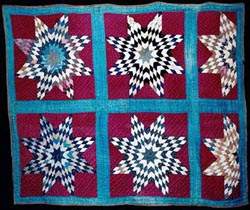
What motivates people to participate in the Quilt Documentation Project? The documentation days attract not only quilters and quilt owners, but also visitors who just want to enjoy the stories and the kaleidoscope of quilts, displayed in full for photography. The quilters can meet sister artists who enjoy hearing about their materials and techniques-a rare opportunity for many quilters who often work alone at home, although a few still gather for the final quilting like the traditional quilting bee. Also, they see documentation as a validation of their quilts and quilting expertise.
The documented quilters range in skills, experience, and philosophy-from the traditional quilter who learned from older family women to make everyday quilts for cover; to the quilting revivalist who has learned from quilting guilds, workshops, and popular sources to create fine crafts; to the fiber artist who has applied contemporary academic artistic principles to quilting. With resources now available online as well as in print, quilters of all backgrounds may be inspired by a wide range of patterns and techniques, making categorization difficult.
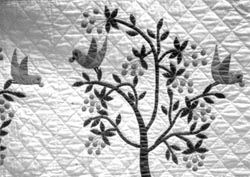
Quilts documented range from utilitarian to artistic, and their stories are as varied as their functions. Some "everyday" quilts are used in various ways until they fall apart. One woman reported that in her family, "My mother spread and placed quilts between the bed springs and mattresses to provide additional padding to stabilize and improve the bed's age and weakness and the lumpiness of the mattress; these quilts were also often put on the floor for us to nap on after lunch during days when we worked in the fields on the farm." Bernice quilter Youree Smith recalls that boredom motivated her to make her first "Star" quilt in 1937, after she and her husband married and began farming. She gathered cotton from their field and carded it with her mother's cards to remove the seeds and fluff it. She has continued to make a couple of quilts per year, giving many to family. While the process of quilting may serve as a pastime or hobby, quilts are often made for specific decorative purposes, shows, gifts for special occasions, and heirlooms. Often, quilts were given as wedding gifts, which might then be used for bedcover or might be passed on through generations as heirlooms, as Virgil Orr reports for his "Star" quilt made by Seany Melder Orr, of Forest Hill, "and given to J. L. and Lonie Monroe Orr on the occasion of their wedding on January 1, 1920, in Glenmora, Louisiana."
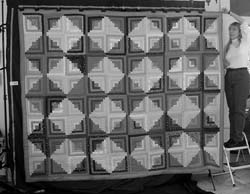
The quilter's background and experience also influence the types and potential functions of quilts, according to stories from our research. For example, Ann Reiley Jones (Baton Rouge, 1989) brought in a quilt given to her grandfather in 1937 by Maggie Skipwith Smith, of Wilson. Accompanying the quilt was her handwritten story about making "Our George Cherry Tree" or "The Tree of Truth," which has 7,820 appliquéd pieces: "My object in designing it was to send it to the World's Fair in Chicago [1933 Century of Progress World Exposition], thinking that should it win first prize, it would, on presentation to the First Lady of the Land [Eleanor Roosevelt], remind her of the first president of the United States, and would have been made by the first woman mayor of Louisiana; however, I did not get [it] to Memphis in time to be judged with the other quilts, but [it] was returned to me with an "Honorable Mention" ribbon on it." Purportedly the only quilt Mrs. Smith made, it documents and celebrates its maker's groundbreaking political efforts.
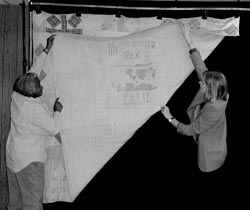
Among the equally compelling contemporary quilts is one with a strikingly realistic appliquéd oil rig, commemorating a husband's work off the coast of St. Bernard. Another quilt, based on family experiences and made by Peggy Rogers of New Orleans, is dizzying in its complexity. The design, 16 concentric circles comprising 3,072 small triangles, was adapted from a marble floor in Herculaneum, Italy, and drawn out by her husband with a yardstick.
Though our research is still incomplete by any measure, these quilts provide a peak into the rich data, which supports Roach's 1992 assertion that quiltmaking is "one of the most prevalent domestic folk crafts in Louisiana." Also quilting is growing as a contemporary craft, with many new practitioners, as our research in New Orleans proves. Certainly, quilts are even more highly valued today as an art form and as important symbolic objects. More processing and analysis remain before we can provide a complete view of Louisiana quilts, and many more artists and stories deserve to be documented; however, we now have many pieces of our state quilt document to stitch together.
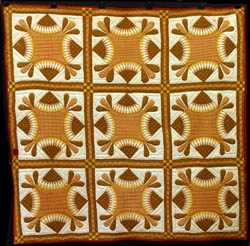
Sources
The Alliance for American Quilts.
Freeman, Roland. A Communion of the Spirits: African American Quilters, Preservers, and Their Stories. Nashville: Rutledge Hill Press, 1996.
Hedges, Elaine, Pat Ferrero, Julie Silber. Hearts and Hands: Women, Quilts, and American Society. Nashville: Rutledge Hill Press, 1987.
Horton, Laurel. Quiltmaking in America: Beyond the Myths. Nashville: Rutledge Hill Press, 1994.
Roach, Susan. "Keep Your Mind and Your Hands Busy:" Expressive Dimensions of the Lone Quilter. Louisiana Folklore Miscellany.
_____. Traditional Quiltmaking in Louisiana. 1992 Louisiana Folklife Festival Program Book.


